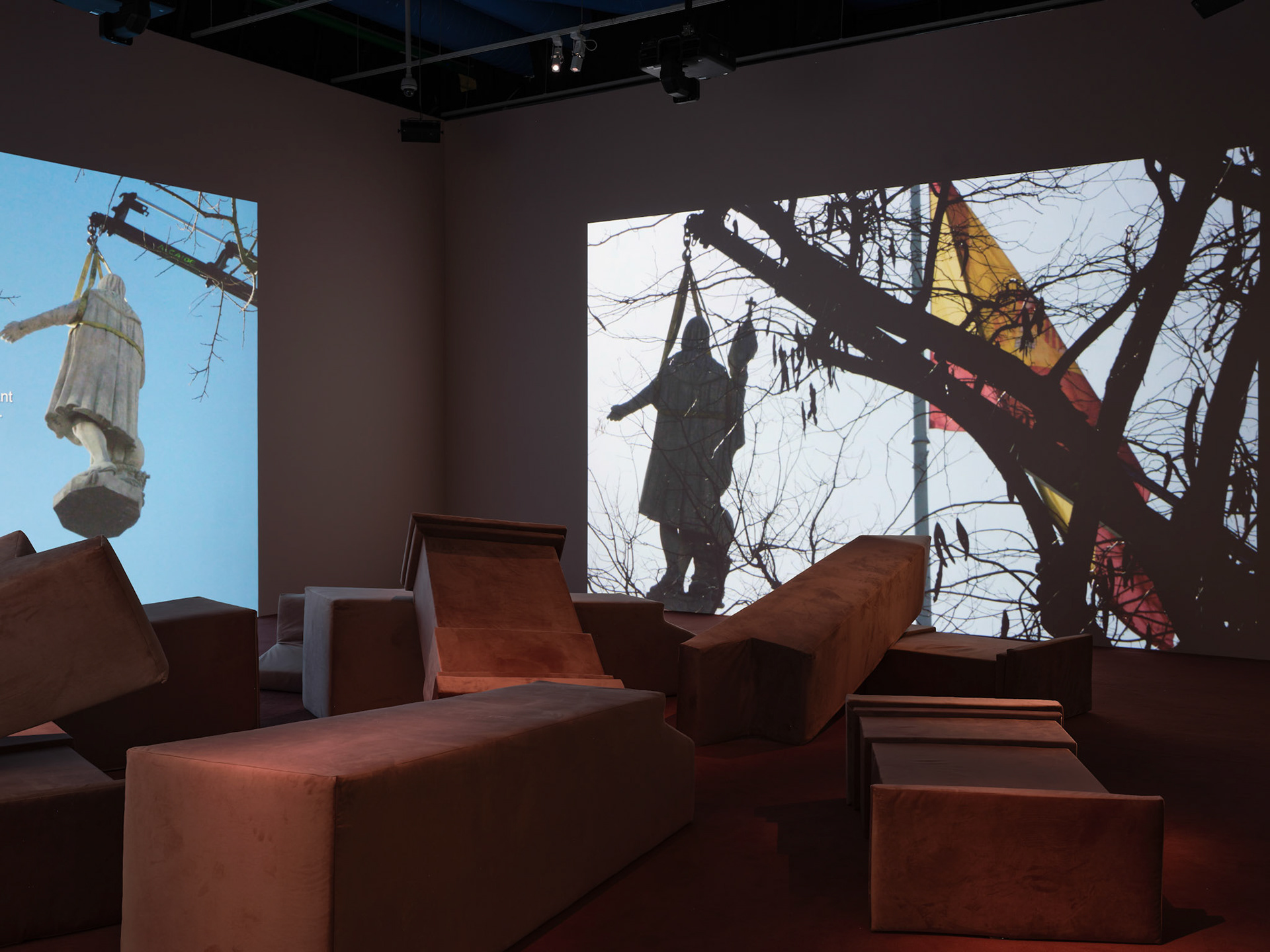Iván Argote: l’air de rien by Kathryn Weir
Iván Argote returns often to questions about public space in his artistic practice: he makes visible how squares and monuments from Bogota to Paris to Douala reflect a past status quo that has been naturalised, and asks how to create spaces that offer other narratives. In the film La plaza del Chafleo (2018-19), he invents the verb ‘to chaffle’ for activities people enjoy while in the public square—kissing, chanting political slogans, creating ephemeral artworks—and tells us of ‘The Poetry Fountain’ in Buenos Aires, where from the mid-1990s people gathered to read poetry, until one day, in 2008, the city drained the water from the basin. Ten years later, Argote gathered ten thousand litters of water and a group of people with garden hoses to bring the fountain back to life, after which the municipality finally decided to reopen the water mains; up until today the Poetry Fountain is again filled with water. The artist asks, ‘What if to chaffle were to fill an idea or place with meaning?’. (1)
Intensely inventive in the investigation of artistic questions and ideas, Argote’s practice takes forms that include drawings, comics and paintings, as well as the sculptures, installations, films and performative interventions for which he is better known. Playful humour and fictional speculation are approaches that the artist frequently adopts across different bodies of work. His projects lay bare difficulties in creating dialogue on disparities in living conditions and on the political and historical issues this raises, proposing tools and strategies that help to define common values and create social tissue. Drawing on experiences of turbulent years in Colombia, he speaks of tenderness as a ground for listening and moving beyond antagonism to a recognition of complex interconnectedness.
In Argote’s installation for the Prix Marcel Duchamp, Air de jeux, fallen monuments in pink velour are strewn across the gallery to provide seating, evoking the soft sculpture of Claes Oldenburg. The title combines a reference to the French expression for playgrounds in public parks with a clin d’œil to Marcel Duchamp’s readymade Air de Paris 1919, a pharmacist’s glass vial emptied of its contents and sealed with just Paris air inside. In one of three videos projected around the soft sculptural debris, we see a monument in front of the Invalides in Paris that is dedicated to Joseph Gallieni, a military figure that the artist’s collaborator, feminist and anti-colonial activist Francoise Vergès, tells us was responsible for massacres and forced labour, notably in Madagascar. She comments, ‘these statues and monuments say nothing of the reality of the slavery and genocide, devastation and destroyed lives, nor of the cultural, political and artistic resistance to these attacks’. (2) In Argote’s ‘futuristic films’ in Air de jeux, Gallieni descends from his pedestal with the help of a crane, as does also a statue of Christopher Columbus in Madrid that the artist then promenades on the back of a truck, to general bemusement. The third video-action takes place in the Piazza del Popolo, where, with Argote’s help, the Flaminio obelisk performs an aerial choreography. Rome features more obelisks than any other city, accumulated since 10 BCE when Emperor Augustus carried away the Flaminio obelisk to celebrate the conquest of Egypt; he started a mania that would extend from the Medicis to Mussolini. Archetypes of public monuments, obelisks testify to worlds ending and beginning. (3) Today, as art historian Alessandro Gallicchio underlines, monuments can no longer celebrate a univocal history of empires or nation states, but must rather ‘explore the plurality of points of view on memory and the past’; they may even help to navigate uncomfortable and contested histories. (4) Iván Argote is fundamentally interested in playfully and collectively considering how we can change the paradigm: ‘to replace a statue by another one is not the point, and not at all a goal. The goal is to generate other ways, first, to conceive public space, and second, of thinking the idea of memorial and monument ... I feel that art should be an invitation to a conversation; it shouldn’t be an authoritarian gesture—as most monuments are, by the way—or a lesson on how people should see the world. Art should be a place where we could sit and talk.’ (5)
(1) Iván Argote, Plaza del Chafleo (2018-19). Artists Enrique Banfi and Silvana Perl created the poetry project at the fountain in Mitre Square in Buenos Aires.
(2) Françoise Vergès and Seumboy Vrainom :€, De la violence coloniale dans l’espace public : Visite du triangle de la Porte Dorée à Paris, Shed Publishing, Paris and Marseille, 2021, pp.21-22.
(2) Françoise Vergès and Seumboy Vrainom :€, De la violence coloniale dans l’espace public : Visite du triangle de la Porte Dorée à Paris, Shed Publishing, Paris and Marseille, 2021, pp.21-22.
(3) Iván Argote and Kathryn Weir, ‘What is a Monument? A conversation between Iván Argote and Kathryn Weir’ in Iván Argote: Here together, Perrotin, Paris, 2022, p.24.
(4) Alessandro Galicchio, ‘Monument en mouvements : Artistes et chercheurs facent aux monumentalisations contemporaines’, dans Monument en mouvements : Artistes et chercheurs facent aux monumentalisations contemporaines, Gli Ori Redazione, Pistoia, 2020, p.20.
(4) Alessandro Galicchio, ‘Monument en mouvements : Artistes et chercheurs facent aux monumentalisations contemporaines’, dans Monument en mouvements : Artistes et chercheurs facent aux monumentalisations contemporaines, Gli Ori Redazione, Pistoia, 2020, p.20.
(5) Iván Argote and Kathryn Weir, op cit, pp. 22, 24.

PMD 2022

PMD 2022

PMD 2022

PMD 2022











